Information Technology Reference
In-Depth Information
Since the same performance can be produced by two entirely different
structural systems one may wonder what is Nature's preferred way of
accomplishing these performances: by action or by interaction networks?
This question can, however, be answered only from an ontogenetic point of
view. Since the “easy” way to solve a particular problem is to use most of
what is already available, during evolution the development of complex net
structures of either kind may have arisen out of a primitive nucleus that
had a slight preference for developing in one of these directions. Never-
theless, there are the two principles of “action at a distance” and “action by
contagion”, where the former may be employed when it comes to highly
specified, localized activity, while the latter is effective for alerting a whole
system and swinging it into action. The appropriate networks which easily
accommodate these functions are obvious, although the equivalence prin-
ciple may reverse the situation.
Examples
(i) Gaussian, Lateral Inhibition
We give as a simple example an interaction net that produces highly local-
ized responses for not-well-defined stimuli. Consider a linear network with
purely inhibitory interaction in the form of a normal distribution:
[
]
2
()
=
(
)
~--
(
)
KKx
-
x
exp
p x
x
.
1
2
1
2
As a physiological example one may suggest the mutually inhibiting action
in the nerve net attached to the basilar membrane which is assumed to be
responsible for the sharp localization of frequencies on it.
Suppose the stimulus—in this case the displacement of the basilar mem-
brane as a function of distance
x
from its basal end—is expressed in terms
of a Fourier series
()
=+
Â
(
)
+
Â
(
)
s
xa
a
sin
2
p
i
x
l
b
cos
2
p
i
x
l
,
o
i
i
i
=
012
, , ,...,
with coefficients
a
i
,
b
i
and fundamental frequency l. It can be shown from
eq. (110) that the response will be also a periodic function which can be
expressed as a Fourier series with coefficients
a
i
and
b
i
. These have the fol-
lowing relation to the stimulus coefficients:
a
a
*
b
b
*
p
i
i
==
+-
(
.
[
]
41
2
)
p
exp
pl
i
i
Since this ratio goes up with higher mode numbers
i
, the higher modes are
always enhanced, which shows that indeed an interaction function with
inhibitory normal distribution produces considerable sharpening of the
original stimulus.







Search WWH ::

Custom Search